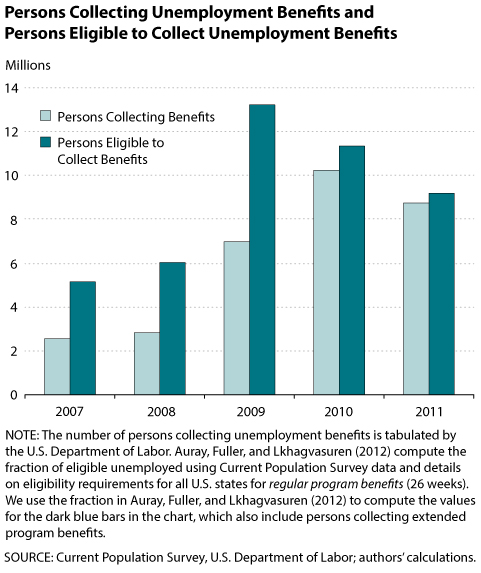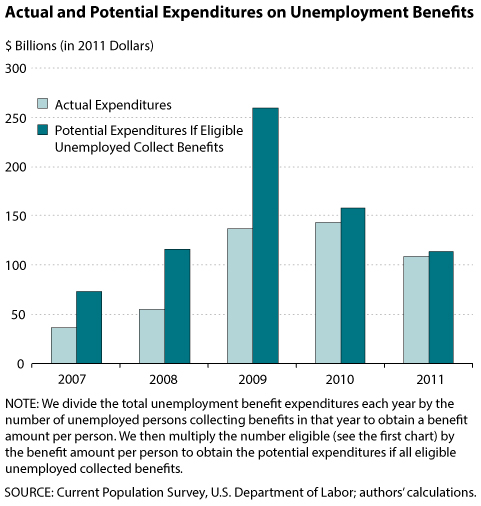Unemployment Benefits: How Much Money Goes Unclaimed?
The unemployment insurance program in the United States operates at the state level. Each state sets its benefits level and eligibility criteria. Three primary criteria are used to determine eligibility for benefits. First, the individual must have accumulated enough earnings or worked a minimum number of weeks during the previous year. Second, only those who lost their jobs through no fault of their own are eligible. Third, the duration of benefits is limited. Unemployment benefits typically last a maximum of 26 weeks. During periods of high unemployment, benefits may be extended. 1
In this essay, we document a lesser-known fact about the U.S. unemployment insurance program: Not all who are eligible to receive unemployment benefits actually collect them. We then document these unclaimed benefits over recent years (2007–11).

The first chart shows the number of persons who collected unemployment benefits and the number eligible to collect benefits over the 2007-11 period. The take-up rate (the ratio of the number of persons collecting benefits to the number of persons eligible to collect them) typically increases during recessions; however, the take-up rate has rarely hit 100 percent. In fact, during the recent recession (2007-09), only about 50 percent of those eligible collected their benefits.
A person's eligibility to collect unemployment benefits typically expires after 26 weeks, but benefits may be extended during periods of high unemployment. For instance, the Federal-State Extended Unemployment Compensation Act of 1970 has been used repeatedly to extend unemployment benefits past the usual 26 weeks, and the Emergency Unemployment Compensation program has been used four times to extend benefits between June 2008 and December 2009. Such extensions expand benefits eligibility to more unemployed persons, in addition to the newly unemployed. For example, in 2010, 4.4 million unemployed persons collected regular program benefits (26 weeks of eligibility) and 5.8 million collected extended benefits.
During the recent recession, the number of unemployed eligible to collect benefits increased from 5.2 million in 2007 to 13.2 million in 2009.2 Despite the more than twofold increase in the number of eligible persons, the take-up rate barely increased, from 49 percent to 53 percent. However, as the unemployment rate continued to remain high and further extensions were allowed, the take-up rate increased to more than 90 percent in 2010 and 2011.

A natural question is how high would unemployment benefit expenditures be if everyone eligible to receive unemployment benefits did indeed collect them? In other words, how much did the unemployment insurance program "save" because some of those eligible chose not to claim their benefits? The second chart shows this calculation for the years 2007 to 2011. It documents both the actual benefits paid by the unemployment insurance program and the benefits that would have been paid if every eligible unemployed person had chosen to collect benefits. In 2009, the actual benefits paid were less than $150 billion, but the potential expenditures could have been more than $250 billion (both amounts measured in 2011 dollars). Thus, the unclaimed benefits—the "savings"—for unemployment insurance totaled more than $100 billion.
In summary, even though actual unemployment expenditures increased almost threefold during the recent recession (2007-09), the expenditures would have been substantially higher if more eligible persons had chosen to collect their benefits.
Notes
1 The unemployment insurance program does not cover all jobs. For example, self-employment is not covered. Thus, a worker may meet all other eligibility criteria, but if the job is not covered under the program, then the worker is not eligible to collect benefits.
2 The number of unemployed persons increased from 7.1 million in 2007 to 14.3 million in 2009. However, not all of the unemployed were eligible to collect benefits.
Reference
Auray, Stephane; Fuller, David L. and Lkhagvasuren, Damba. "Unemployment Insurance Take-up Rates in an Equilibrium Search Model." Working paper, Concordia University, October 2, 2012.
© 2013, Federal Reserve Bank of St. Louis. The views expressed are those of the author(s) and do not necessarily reflect official positions of the Federal Reserve Bank of St. Louis or the Federal Reserve System.


 follow @stlouisfed
follow @stlouisfed